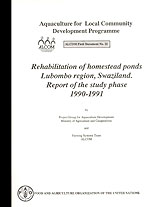
Report of the study phase
1990–1991
| ALCOM | GCP/INT/555/SWE |
| Aquaculture for Local Community Development Programme | GCP/RAF/277/BEL |
ALCOM Field Document No. 22
 | Rehabilitation of homestead ponds Lubombo region, Swaziland. Report of the study phase 1990–1991 |
| CONTENTS |
by
Project Group for Aquaculture Development
Ministry of Agriculture and Cooperatives
and
Farming Systems Team
ALCOM
Funding Agencies:
SWEDISH INTERNATIONAL DEVELOPMENT AUTHORITY
BELGIAN ADMINISTRATION FOR DEVELOPMENT CO-OPERATION
Executing Agency:
FOOD AND AGRICULTURE ORGANIZATION OF THE UNITED NATIONS
Mbabane, Swaziland & Harare, Zimbabwe, January 1994
Hyperlinks to non-FAO Internet sites do not imply any official endorsement of or responsibility for the opinions, ideas, data or products presented at these locations, or guarantee the validity of the information provided. The sole purpose of links to non-FAO sites is to indicate further information available on related topics.
This electronic document has been scanned using optical character recognition (OCR) software. FAO declines all responsibility for any discrepancies that may exist between the present document and its original printed version.
1 INTRODUCTION
1.1 Pilot project background
1.2 Participants
1.3 Study phase objectives and activities
2 SURVEY METHODOLOGY
2.1 Scope
2.2 Survey frame - the sample
2.3 Methods
3 SURVEY FINDINGS AND CONCLUSIONS
3.1 Socio-economic characteristics
3.2 Farming systems
3.3 Fish farming practices
3.4 Fish consumption and preferences
3.5 Extension and community organizations
4 POTENTIAL FISH CULTURE SYSTEMS
4.1 Culture of Clarias qariepinus
4.2 Culture of Cyprinus carpio
4.3 Selection of fish culture systems
4.4 Farmer-managed trials
5 RECOMMENDATIONS FOR FOLLOW-UP
5.1 Improved fish culture systems
5.2 Effective extension services
5.3 Socio-economic impact
5.4 Farmed-fish marketing
Figures
1. Administrative regions of Swaziland
2. Topographical regions of Swaziland
Tables
1: Mean monthly water temperatures at Nyetane Fish Farm
2 Distribution of cultivated land by homesteads
3. Maize production by farm size
5: Labour distribution of homestead members (per cent)
6: Labour availability in man-years
7: Distribution of ponds by size
8: Age distribution of fish in fish ponds
10. Stated preferences for fish types
11. Main reasons for fish preferences
13. Involvement in local organizations
14. Composition of Farmix Trout Pellets
15. Recommended feeding levels (% body weight/day) and corresponding growth rates (% body weight/day) for C. qariepinus from 1 to 205 gr. between 20 and 35°C
16. Growth calculations for C. qariepinus at Nyetane Fish Farm with optimum feeding
18: Cost of fingerlings per kg of produced fish at different final weights
19: Feed and fingerling cost per kg of produced fish at different final weights
20: Optimum feeding levels and expected growth for carp at 23°C
21: Two year production of carp
22: Potential fish farmers for farmer-managed trials
Appendices
2: Details of selected fish farms
The pilot project “Rehabilitation of homestead ponds, Swaziland”, aims at increasing the supply of protein and providing rural communities with income-generating opportunities through aquaculture.
The study phase of the project was carried out during 1990–91 by the Project Group for Aquaculture Development, Ministry of Agriculture and Co-operatives, Swaziland, and the ALCOM Farming Systems Team.
Under the study phase, a socio-economic survey was carried out of 46 individual pond-owners in the Lubombo region plus an equal sample of neighbouring and distant farmers.
This document reports on the conduct and findings of the study phase.
ALCOM is a regional aquaculture and fisheries programme of the FAO (Food and Agriculture Organization of the United Nations). Based in Harare, Zimbabwe, it covers all the member-countries of SADC (Southern African Development community): Angola, Botswana, Lesotho, Malawi, Mozambique, Namibia, Swaziland, Tanzania, Zambia and Zimbabwe.
ALCOM activities include introduction and extension of fish farming; integration of aquaculture into existing farm systems; surveys of fish farmers; better utilization of the fisheries potential of small water bodies; improving the role of women in fisheries and aquaculture; assistance in planning and project formulation'; information dissemination.
The aim of ALCOM is to assist member-countries improve the living standards of rural population through the practise of aquaculture. Towards this end, pilot activities are conducted in member-countries to demonstrate new techniques, technologies or methodologies. Successes achieved, ideas derived, lessons learnt, are applied on a wider scale by member governments.
ALCOM is funded by Sweden and Belgium. Its preparatory phase began in 1986, and its first implementation phase in 1990.